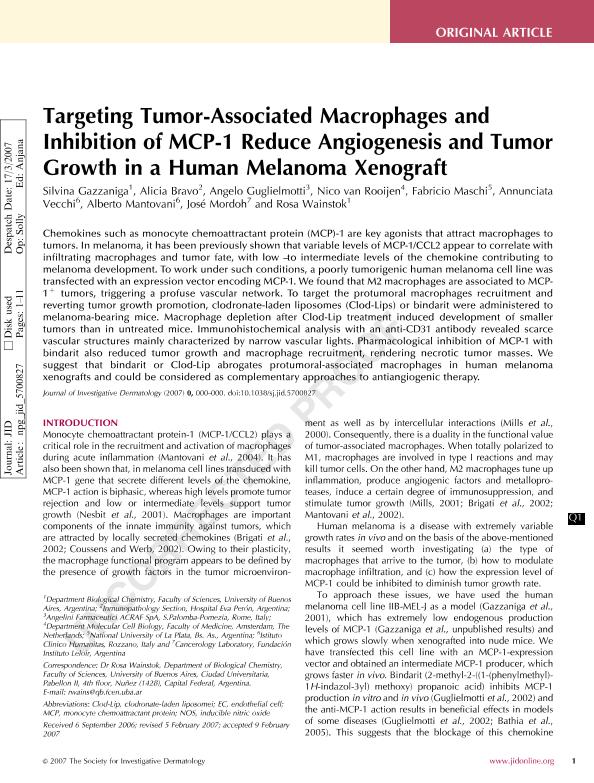Mostrar el registro sencillo del ítem
dc.contributor.author
Gazzaniga, Silvina Noemí

dc.contributor.author
Bravo, Alicia I.
dc.contributor.author
Guglielmotti, Angelo
dc.contributor.author
Rooijen, Nico van
dc.contributor.author
Maschi, Fabricio

dc.contributor.author
Vecchi, Annunciata
dc.contributor.author
Mantovani, Alberto
dc.contributor.author
Mordoh, Jose

dc.contributor.author
Wainstok, Rosa

dc.date.available
2017-12-15T20:16:23Z
dc.date.issued
2007
dc.identifier.citation
Gazzaniga, Silvina Noemí; Bravo, Alicia I.; Guglielmotti, Angelo; Rooijen, Nico van; Maschi, Fabricio; et al.; Targeting Tumor-Associated Macrophages and Inhibition of MCP-1 Reduce Angiogenesis and Tumor Growth in a Human Melanoma Xenograft; Elsevier; Journal Of Investigative Dermatology; 127; 8; 2007; 2031-2041
dc.identifier.issn
0022-202X
dc.identifier.uri
http://hdl.handle.net/11336/30811
dc.description.abstract
Chemokines such as monocyte chemoattractant protein (MCP)-1 are key agonists that attract macrophages to tumors. In melanoma, it has been previously shown that variable levels of MCP-1/CCL2 appear to correlate with infiltrating macrophages and tumor fate, with low to intermediate levels of the chemokine contributing to melanoma development. To work under such conditions, a poorly tumorigenic human melanoma cell line was transfected with an expression vector encoding MCP-1. We found that M2 macrophages are associated to MCP-1+ tumors, triggering a profuse vascular network. To target the protumoral macrophages recruitment and reverting tumor growth promotion, clodronate-laden liposomes (Clod-Lip) or bindarit were administered to melanoma-bearing mice. Macrophage depletion after Clod-Lip treatment induced development of smaller tumors than in untreated mice. Immunohistochemical analysis with an anti-CD31 antibody revealed scarce vascular structures mainly characterized by narrow vascular lights. Pharmacological inhibition of MCP-1 with bindarit also reduced tumor growth and macrophage recruitment, rendering necrotic tumor masses. We suggest that bindarit or Clod-Lip abrogates protumoral-associated macrophages in human melanoma xenografts and could be considered as complementary approaches to antiangiogenic therapy.
dc.format
application/pdf
dc.language.iso
eng
dc.publisher
Elsevier

dc.rights
info:eu-repo/semantics/openAccess
dc.rights.uri
https://creativecommons.org/licenses/by-nc-sa/2.5/ar/
dc.subject.classification
Medicina Critica y de Emergencia

dc.subject.classification
Medicina Clínica

dc.subject.classification
CIENCIAS MÉDICAS Y DE LA SALUD

dc.title
Targeting Tumor-Associated Macrophages and Inhibition of MCP-1 Reduce Angiogenesis and Tumor Growth in a Human Melanoma Xenograft
dc.type
info:eu-repo/semantics/article
dc.type
info:ar-repo/semantics/artículo
dc.type
info:eu-repo/semantics/publishedVersion
dc.date.updated
2017-11-03T20:23:03Z
dc.journal.volume
127
dc.journal.number
8
dc.journal.pagination
2031-2041
dc.journal.pais
Países Bajos

dc.description.fil
Fil: Gazzaniga, Silvina Noemí. Universidad de Buenos Aires. Facultad de Ciencias Exactas y Naturales. Departamento de Química Biológica; Argentina. Consejo Nacional de Investigaciones Científicas y Técnicas; Argentina
dc.description.fil
Fil: Bravo, Alicia I.. Provincia de Buenos Aires. Ministerio de Salud. Hospital Interzonal de Agudos "Eva Perón"; Argentina
dc.description.fil
Fil: Guglielmotti, Angelo. Angelini Farmaceutici; Italia
dc.description.fil
Fil: Rooijen, Nico van. No especifica;
dc.description.fil
Fil: Maschi, Fabricio. Universidad Nacional de La Plata; Argentina
dc.description.fil
Fil: Vecchi, Annunciata. Istituto Clinico Humanitas; Italia
dc.description.fil
Fil: Mantovani, Alberto. Istituto Clinico Humanitas; Italia
dc.description.fil
Fil: Mordoh, Jose. Fundación Instituto Leloir; Argentina. Consejo Nacional de Investigaciones Científicas y Técnicas; Argentina
dc.description.fil
Fil: Wainstok, Rosa. Universidad de Buenos Aires. Facultad de Ciencias Exactas y Naturales. Departamento de Química Biológica; Argentina. Consejo Nacional de Investigaciones Científicas y Técnicas; Argentina
dc.journal.title
Journal Of Investigative Dermatology

dc.relation.alternativeid
info:eu-repo/semantics/altIdentifier/doi/http://dx.doi.org/10.1038/sj.jid.5700827
dc.relation.alternativeid
info:eu-repo/semantics/altIdentifier/url/http://www.sciencedirect.com/science/article/pii/S0022202X15335144
Archivos asociados
